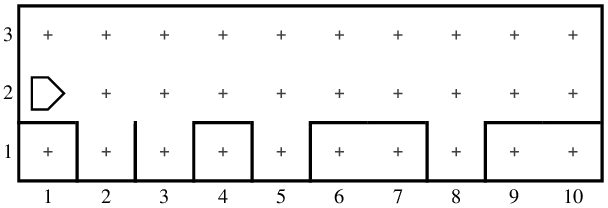


|
Ch1 Ch2 Ch3 Ch4 Ch5 |

|
As useful as it is, the ability to define new functions does not actually enable Karel to solve any new problems. The name of a function is merely shorthand for a specific set of instructions. It is therefore always possible to expand a program written as a series of function calls into a single function that accomplishes the same task, although the resulting code is likely to be long and difficult to read. The instructions are still executed in a fixed order that does not depend on the state of Karel’s world.
Before you can solve more interesting problems, you must be able to write programs that transcend this strictly linear, step-by-step operation. To do so, you need to learn several new statements in Karel’s programming language that enable Karel to examine its world and change its execution pattern accordingly.
Statements that affect the order in which a program executes instructions are called control statements. Control statements fall into the following two classes:
if
statement.for statement that allows you to repeat a set of
instructions a fixed number of times, and a while statement
that allows you to repeat a set of instructions as long as some
condition holds.
Examining Karel’s world
The conditional and iterative control statements each require that Karel be able to ask questions about its world, such as the following:
Questions such as these are expressed using calls to
built-in functions that have
yes-or-no answers.
In programming, functions that return a
yes-or-no answer—which as you
will soon discover correspond to the values True
and False—are called
predicate functions.
Figure 3-1 shows the predicate functions that are built into Karel’s language.
front_is_clear() |
front_is_blocked() |
left_is_clear() |
left_is_blocked() |
right_is_clear() |
right_is_blocked() |
beepers_present() |
no_beepers_present() |
beepers_in_bag() |
no_beepers_in_bag() |
facing_north() |
not_facing_north() |
facing_east() |
not_facing_east() |
facing_south() |
not_facing_south() |
facing_west() |
not_facing_west() |
For example, the three questions listed earlier can be expressed in Karel programs like this:
front_is_blocked()beepers_present()beepers_in_bag()Each of the predicate functions requires an empty set of parentheses, just as Karel’s other built-in functions do.
It is also helpful to note that every predicate function in
Figure 3-1 is paired with a second one that checks
the opposite condition.
For example, you can use the
front_is_clear
function to check whether the path ahead of Karel is clear or the
front_is_blocked
function to see whether a wall is blocking the way.
Choosing the right condition requires you to think about the logic of
the problem and figure out which condition is easiest to test.
The if statement
In both Karel and Python, conditional execution is expressed
using the if statement, which has one of the two following
forms:
or
The first form of the if statement is useful
when you want to perform an action only under certain conditions.
The second—which comes up less frequently—is appropriate
when you need to choose between two alternative courses of action.
The if statement illustrates
several features common to all control statements in Karel.
The control statement begins with a header that
indicates the type of control statement along with any additional
information to control the program flow.
The lines that are governed by a conditional statement are then
indented relative to the header line, conventionally using four
spaces.
The indented statements represent the body
of the control statement.
To give you a sense of where the if statement
might come in handy, let’s go back to the
pothole-filling program presented at the end of
Chapter 2.
Before filling the pothole in the
fill_pothole function,
Karel might want to check whether some other repair crew has already
filled the hole on that corner with a beeper.
If so, Karel does not need to put down a second one.
You can use the if statement to modify the
definition of the fill_pothole
function so that Karel puts down a beeper only if there is not already a
beeper on that corner.
The new definition of fill_pothole
looks like this:
It often makes sense to include if statements
in a function that check whether it is appropriate to apply that
function in the current state of the world.
For example, calling the fill_pothole
function works correctly only if Karel is facing east directly above a
hole.
You can use the
right_is_clear
test to determine whether there is a hole to the south, which is the
direction to the right of the one that Karel is facing.
The following implementation of
fill_pothole
includes this test along with the
no_beepers_present
test you have already seen:
The code in this extended definition of
the fill_pothole
function shows three different levels of indentation.
The body of the entire function is indented four spaces relative to
the def keyword that introduces it,
everything after the if statement at the top of the
function body is executed only if Karel’s right is clear and
is therefore indented with four more spaces,
and the single line controlled by the
no_beepers_present
test is indented an additional four spaces.
The indentation makes it easier to see exactly which statements are be affected by a control statement. This indentation is particularly important when the body of a control statement contains other control statements, as in this example. Control statements that occur inside other control statements are said to be nested.
The for statement
The for statement in Karel is used to indicate
that you want to repeat a sequence of statements a predetermined number
of times.
The general form of Karel’s for statement
looks like this:
The somewhat convoluted form of the for
statement is chosen so that it matches the syntax of the
for statement in Python.
In Python, you will often have occasion to replace the i
in this pattern with a different name.
In Karel, it works perfectly well to consider the name i
to be part of the required syntax and use it every
time you write a for statement.
As a simple illustration of the for statement,
you could rewrite the definition of
turn_right
like this:
Since this definition is not appreciably shorter than the
original one that simply repeated
turn_left() three times—and
the fact that
turn_right()
is available in the turns library—defining
turn_right()
in this way is not all that useful.
The example does, however, give you a sense of what the
for statement does in a context in which its
purpose is clear.
To see how the for statement can be used in
the context of a programming problem, suppose you wanted to fill
every pothole in a road where you were somehow fortunate enough
to know the length of the road in advance.
Suppose, for example, that the road looked like this:

Your mission is to write a program that instructs Karel to fill all ten holes in this road.
Because the statement of the problem tells you that there
are exactly ten corners in the world, you can solve this problem by
calling the
fill_pothole
function ten times, once for every corner on 2nd Street.
In between each of those calls, you want Karel to move forward so
that it can check and fill any pothole on the next corner.
Although you can certainly use a for
statement to accomplish this goal, you can’t write
|
def fill_ten_potholes():
for i in range(10):
fill_pothole()
move() |

|
As the icon to the right of the program indicates, this program contains a logical flaw—the sort of error that programmers call a bug. This website and the Python reader use the bug symbol to mark functions that contain errors, to ensure that you don’t accidentally use those examples as models for your own code.
The bug in this particular example illustrates a programming problem called a fencepost error. The name comes from the fact that it takes one more fence post than you might think to fence off a particular distance. How many fence posts, for example, do you need to build a 100-foot fence if the posts are always positioned 10 feet apart? The answer is 11, as illustrated by the following diagram:

The situation facing Karel in the
pothole-filling problem has much the same
structure.
In order to fill potholes in a street that is ten corners long, Karel
has to check for ten potholes but only has to move nine times.
Because Karel starts and finishes at an end of the roadway, it needs to
execute one fewer move instruction than the number of
corners it tries to fill.
In the
fill_ten_potholes
program as written,
Karel would try to move through the wall at the end of 2nd Street,
which would signal an error.
Once you discover this bug, fixing it is easy. Again, if you know the roadway is ten corners long, you can rewrite the program like this:
The for loop in this revised program executes
both the
fill_pothole
and the
move
functions for the first nine corners, and then uses a separate
fill_pothole
call—this one outside the body of the for loop—to
check for a pothole under the last corner.
The for statement is useful only when you know
in advance the number of repetitions you need to perform.
In most applications, the number of repetitions is controlled by the
specific nature of the problem.
For example, it seems unlikely that a
pothole-filling robot could always count on the
roadway being exactly ten corners long.
It would be much better if Karel could continue to fill holes until it
encountered some condition that caused it to stop, such as reaching the
end of the street.
To write such a program, you need to use the while statement
described in the following section.
The while statement
In both Karel and Python, the while
statement has the following general form:
As was true for the if, the conditional test is
chosen from the set of predicate functions listed in
Figure 3-1.
A simple and surprising useful example of the
while statement is the function
move_to_wall,
which looks like this:
When Karel runs the
move_to_wall
function, it begins by calling
front_is_clear
to see whether it can move forward.
If so, it executes the move function to move forward to
the next corner.
The program then goes back to the beginning of the while
loop and checks the condition again.
At some point, the
front_is_clear
function will indicate that the way forward is not clear, at
which point the while loop ends and
move_to_wall
returns to its caller.
You can use a similar pattern to write a more general
solution to the pothole-filling problem,
but you have to remember the fencepost problem described in the
previous section.
Karel has to keep moving as long as the front is clear, but even
if it isn’t, it needs to check the last corner for a pothole.
The code for
fill_all_potholes
therefore looks like this:
Figure 3-2 shows an animation of the
fill_all_potholes
program so that you can trace through its operation.
|

|
Ch1 Ch2 Ch3 Ch4 Ch5 |

|